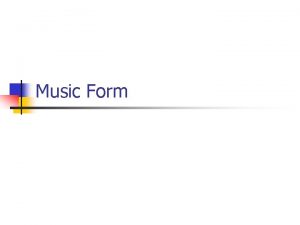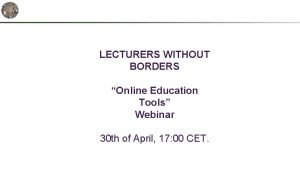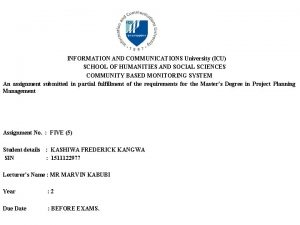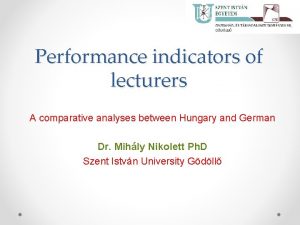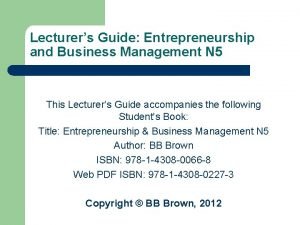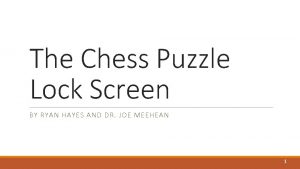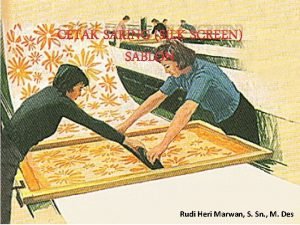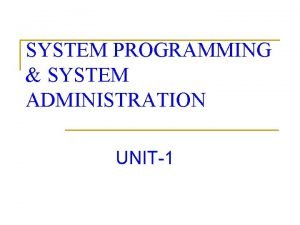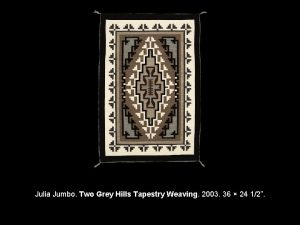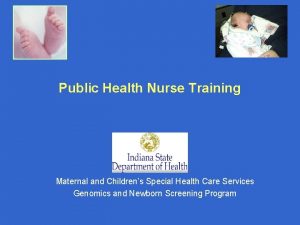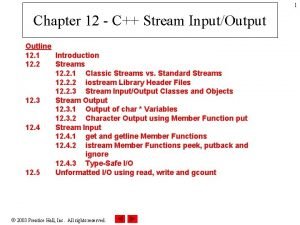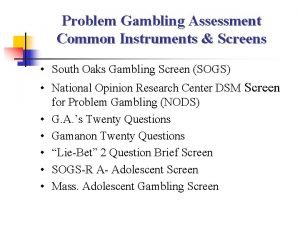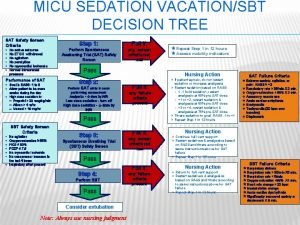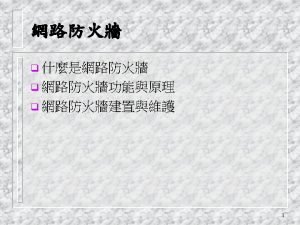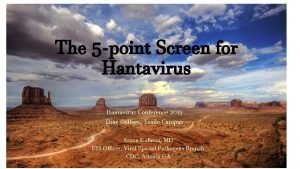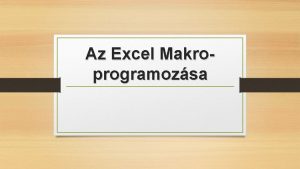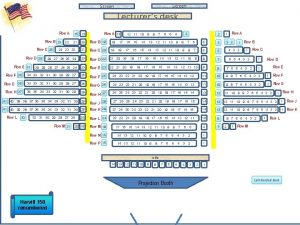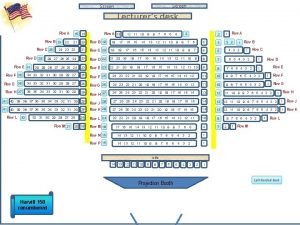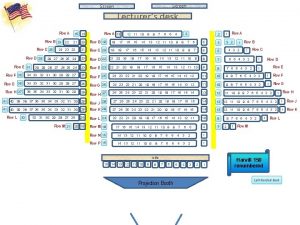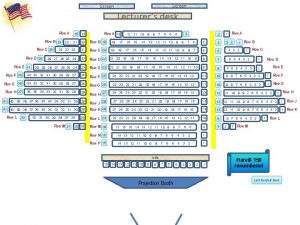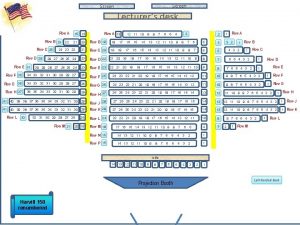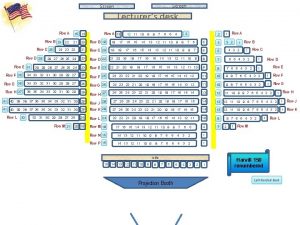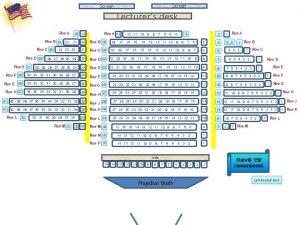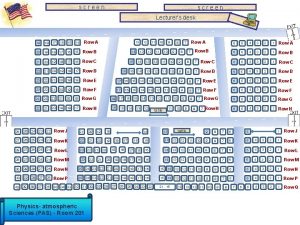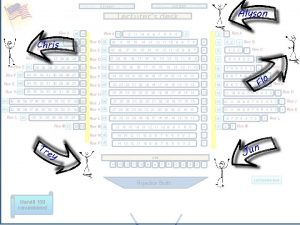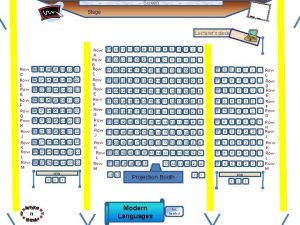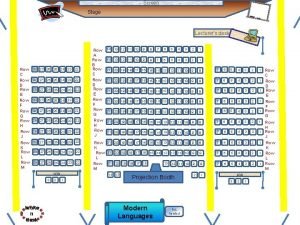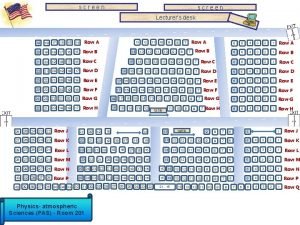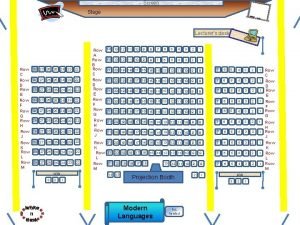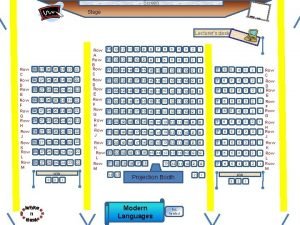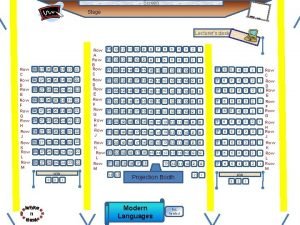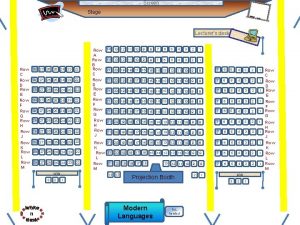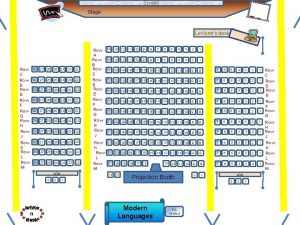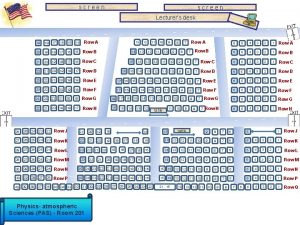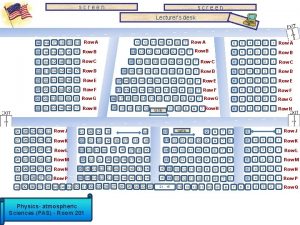screen Lecturers desk Row A 13 8 Row


















































- Slides: 50

screen Lecturer’s desk Row A 13 8 Row A 7 16 15 14 20 19 18 17 16 15 Row B 21 20 19 18 17 16 Row C 22 21 20 19 18 17 Row D 23 22 21 20 19 18 Row E 17 16 15 14 13 12 11 10 9 8 7 23 22 21 20 19 18 Row F 17 16 15 14 13 12 11 10 9 8 7 24 23 22 21 20 19 Row G 18 22 21 20 19 18 17 Row H 16 14 16 24 23 22 Row J 21 20 19 18 27 26 25 24 23 Row K 22 21 20 19 28 27 26 25 24 Row L 23 28 27 26 25 24 Row M 30 29 28 27 26 Row N 25 24 23 30 29 28 27 26 Row P 25 24 23 38 9 10 17 25 39 11 18 26 40 12 19 37 36 35 34 33 23 32 22 22 31 30 Physics- atmospheric Sciences (PAS) - Room 201 21 18 9 10 8 Row B 7 4 3 2 1 Row A 6 5 4 3 2 1 Row B 14 13 12 11 10 9 8 7 Row C 6 5 4 3 2 1 Row C 15 14 13 12 11 10 9 8 7 Row D 6 5 4 3 2 1 Row D Row E 6 5 4 3 2 1 Row E Row F 6 5 4 3 2 1 Row F Row G 6 5 4 3 2 1 Row G Row H 6 5 4 3 2 1 Row H 15 14 17 18 11 5 15 16 15 12 14 13 13 12 16 12 11 10 11 table 14 19 20 21 17 13 6 9 10 8 7 9 8 7 table 13 9 8 7 6 5 1 Row J 15 14 13 12 11 10 9 8 7 6 5 4 3 2 1 Row K 17 16 15 14 13 12 11 10 9 8 7 6 5 4 3 2 1 Row L 14 13 12 11 10 9 8 7 6 5 4 3 2 1 Row M 20 19 18 17 16 15 22 21 20 19 18 17 16 15 14 13 12 11 10 9 8 7 6 5 4 3 2 1 Row N 22 21 20 19 18 17 16 15 14 13 12 11 10 9 8 7 6 5 4 3 2 1 Row P 5 4 3 2 1 Row Q 29 28 27 26 25 24 23 22 21 - 15 14 13 12 11 10 9 8 7 6

MGMT 276: Statistical Inference in Management Fall 2015

Homework Assignment in d n a h 5 lting e t s n a e Ple ignm s in Con 22 su r Asse Statisy, ti. Sceptembe omplete nd D a v ripti : Thursd c s e e Du As alw a be ust m ys nd c a d le stap


Just for Fun Assignments Go to D 2 L - Click on “Content” Click on “Interactive Online Just-for-fun Assignments” Complete Assignments 1 – 7 Please note: These are not worth any class points and are different from the required homeworks

By the end of lecture today 9/22/15 Characteristics of a distribution Central Tendency Dispersion Measures of variability Range Standard deviation Variance Memorizing the four definitional formulae

Exam 1 – This Thursday, September 24 th Study guide is online Bring 2 calculators (remember only simple calculators, we can’t use calculators with programming functions) Bring 2 pencils (with good erasers) Bring ID

Schedule of readings Before next exam: September 24 th Please read chapters 1 - 4 & Appendix D & E in Lind Please read Chapters 1, 5, 6 and 13 in Plous • Chapter 1: Selective Perception • Chapter 5: Plasticity • Chapter 6: Effects of Question Wording and Framing • Chapter 13: Anchoring and Adjustment

Homework Assignment No homework Assignment Just study for Exam 1

Standard deviation: The average amount by “Sum which observations deviateofon either side of their mean Square s” Remember, it’s relative to the mean “n-1” is “Degrees of Freedom” Based on difference from the mean Remember, We are thinking in terms of “deviations” Deviation scores Diallo is 0” Preston is 2” Mike is -4” Hunter is -2 Shea is 4 David 0” Generally, (on average) how far away is each score from the mean? Mean Diallo Presto n She Mik a e

If score is within 2 standard deviations (z < 2) “not unusual score” If score is beyond 2 standard deviations (z = 2 or up to 3) “is unusual score” If score is beyond 3 standard deviations (z = 3 or up to 4) “is an outlier” If score is beyond 4 standard deviations (z = 4 or beyond) “is an extreme outlier”

Summary of 7 facts to memorize These would be helpful to know by heart – please memorize areas

Raw scores, z scores & probabilities 68% 95% Please note spatially where 1 standard deviation falls on the curve 99. 7%

Movie Packages We sampled 100 movie theaters (Two tickets, large popcorn and 2 drinks) 12 Frequency 10 8 6 4 2 0 27 28 29 30 31 32 33 34 35 36 37 38 39 40 41 42 43 44 45 46 47 Price per Movie Package Mean = $37 Range = $27 - $47 Standard Deviation = 3. 5

Amount of Bonuses (based on commission) We sampled 100 retail workers 68% 95% 99. 7% Mean = $50 Range = $25 - $75 Standard Deviation = 10

Writing Assignment – Pop Quiz 1. What is a “deviation score” 2. Preston has a deviation score of 2: What does that tell us about Preston? • Is he taller or shorter than the mean? And by how much? • Are most people in the group taller or shorter than Preston 3. Mike has a deviation score of -4: What does that tell us about Mike? • Is he taller or shorter than the mean? And by how much? • Are most people in the group taller or shorter than Mike 4. Diallo has a deviation score of 0: What does that tell us about Diallo? • Is he taller or shorter than the mean? And by how much? • Are most people in the group taller or shorter than Diallo? 5. Please write the formula for the standard deviation of a population 6. Please draw 3 curves showing 1, 2 & 3 standard deviations from mean

Writing Assignment – Pop Quiz 7. What does symbol refer to? • What is itthis called? • What does it mean? • Is it referring to a sample or population? 8. What does symbol refer to? • What is itthis called? • What does it mean? • Is it referring to a sample or population? 9. What does symbol refer to? • What is itthis called? • What does it mean? • Is it referring to a sample or population? 10. What does this symbol refer to? • What is it called? • What does it mean? • Is it referring to a sample or population? 11. What does this symbol refer to?

Writing Assignment – Pop Quiz 12. What does this refer to? • What are they called? • What do they refer to? • How are they different 13. What does this refer to? • What are they called? • How are they different 14. What do these two refer to? • What are they called? • How are they different 15. What does this refer to? • What is it called? • Use it for sample data or population?

Writing Assignment – Pop Quiz 16. What does this refer to? • What are they called? • What do they refer to? • How are they different 17. What does this refer to? • What are they called? • What do they refer to? • How are they different

Writing Assignment – Pop Quiz 1. What is a “deviation score” e How a far a 2. Preston has a deviation scorechofsc 2: What does that tell us about Preston? ore way fro is. And by how much? • Is he taller or shorter than thememean? Pre an? m th e s t h • Are most people in the group taller or shorter than Preston an ton i the s 2” me t 3. Mike has a deviation score of -4: What does that tell us about tha Mike? an aller n mo (tall • Is he taller or shorter than the mean? Mik. And er st) e is by how much? • Are most people in the group taller orthshorter e m 4” sh than Mike ean orte r us about Diallo? 4. Diallo has a deviation score of 0: What does tell that n m (shor than ter much? osthow • Is he taller or shorter than the mean? And by ) Dia ll shorter than Diallo? • Are most people in the group taller or me o is e x an deviation 5. Please write the formula for the standard of a population (ha actly s lf ta am 6. Please draw 3 curves showing 1, 2 & 3 standard from mean ller deviations eh e f sh ight a s ort er) hal

Writing Assignment – Pop Quiz 7. What does symbol refer to? • What is itthis called? sigm a • What does it mean? tion a l u • Is it referring to a sample or population? 8. What does symbol refer to? • What is itthis called? mu • What does it mean? tion a l u p • Is it referring to a sample orpo population? 9. What does symbol refer to? • What is itthis called? x-ba • What does it mean? r le amp s • Is it referring to a sample or population? 10. What does this symbol refer to? • What is it called? s • What does it mean? ple sam • Is it referring to a sample or population? 11. What does this symbol refer to? The st dev andar (po iatio d pul n atio n) Th (po e mea pul n atio n) The (sam mean ple ) The st dev andar d i (sam ation ple ) Each ind ividual score

Writing Assignment – Pop Quiz e pl m sa p S squ ared squa roen d e i pl at l m u sa op Sigm a Deviation scores n pl e p m 14. What do these two refer to? • What are they called? • How are they different Variance sa 12. What does this refer to? • What are they called? • What do they refer to? • How are they different 13. What does this refer to? • What are they called? • How are they different n io t a ul p o at ul io p po Sum of squares 15. What does this refer to? • What is it called? • Use it for sample data or population? Degrees of freedom

rd a d n Sta ation i v e D Writing Assignment – Pop Quiz pu m pl tio la e e n c n a ri Va m e n io at pl l pu sa po 17. What does this refer to? • What are they called? • What do they refer to? • How are they different sa po 16. What does this refer to? • What are they called? • What do they refer to? • How are they different

Exam 1 Review

Let’s try one Albert compared the time required to finish the race for 20 female jockeys and 20 male jockeys riding race horses. He wanted to know who averaged faster rides. Which of the following is true? a. The IV is gender while the DV is time to finish a race b. The IV is time to finish a race while the DV is gender

Let’s try one Albert compared the time required to finish the race for 20 female jockeys and 20 male jockeys riding race horses. He wanted to know who averaged faster rides. The independent variable is a(n) _____ a. b. c. d. Nominal level of measurement Ordinal level of measurement Interval level of measurement Ratio level of measurement

Let’s try one Albert compared the time required to finish the race for 20 female jockeys and 20 male jockeys riding race horses. He wanted to know who averaged faster rides. The dependent variable is a(n) _____ a. b. c. d. Nominal level of measurement Ordinal level of measurement Interval level of measurement Ratio level of measurement

Let’s try one Albert compared the time required to finish the race for 20 female jockeys and 20 male jockeys riding race horses. He wanted to know who averaged faster rides. The independent variable is a(n) _____ a. Discrete b. Continuous

Let’s try one Albert compared the time required to finish the race for 20 female jockeys and 20 male jockeys riding race horses. He wanted to know who averaged faster rides. The dependent variable is a(n) _____ a. Discrete b. Continuous

Let’s try one Albert compared the time required to finish the race for 20 female jockeys and 20 male jockeys riding race horses. He wanted to know who averaged faster rides. Which of the following is true? a. b. c. d. This is a quasi, between participant design This is a quasi, within participant design This is a true, between participant design This is a true, within participant design

Let’s try one Judy is running an experiment in which she wants to see whether a reward program will improve the number of sales in her retail shops. In her experiment she rewarded the employees in her Los Angeles stores with bonuses and fun prizes whenever they sold more than 5 items to any one customer. However, the employees in Houston were treated like they always have been treated and were not given any rewards for those 2 months. Judy then compared the number of items sold by each employee in the Los Angeles (rewarded) versus Houston (not rewarded) stores. In this study, a _______ design was used. a. between-participant, true experimental b. between-participant, quasi experimental c. within-participant, true experimental d. within-participant, quasi experimental

Let’s try one Judy is running an experiment in which she wants to see whether a reward program will improve the number of sales in her retail shops. (As described in previous question). She wants to use her findings with these two samples to make generalizations about the population, specifically whether rewarding employees will affect sales to all of her stores. She wants to generalize from her samples to a population, this is called a. random assignment b. stratified sampling c. random sampling d. inferential statistics

Let’s try one Naomi is interested in surveying mothers of newborn infants, so she uses the following sampling technique. She found a new mom and asked her to identify other mothers of infants as potential research participants. Then asked those women to identify other potential participants, and continued this process until she found a suitable sample. What is this sampling technique called? a. Snowball sampling b. Systematic sampling c. Convenience sampling d. Judgment sampling

Let’s try one Steve who teaches in the Economics Department wants to use a simple random sample of students to measure average income. Which technique would work best to create a simple random sample? a. Choosing volunteers from her introductory economics class to participate b. Listing the individuals by major and choosing a proportion from within each major at random c. Numbering all the students at the university and then using a random number table pick cases from the sampling frame. d. Randomly selecting different universities, and then sampling everyone within the school.

Let’s try one Marcella wanted to know about the educational background of the employees of the University of Arizona. She was able to get a list of all of the employees, and then she asked every employee how far they got in school. Which of the following best describes this situation? a. census b. stratified sample c. systematic sample d. quasi-experimental study

Let’s try one Mr. Chu who runs a national company, wants to know his Information Technology (IT) employees from the West Coast compare to his IT employees on the East Coast. He asks each office to report the average number of sick days each employee used in the previous 6 months, and then compared the number of sick days reported for the West Coast and East Coast employees. His methodology would best be described as: a. time-series comparison b. cross-sectional comparison c. true experimental comparison d. both a and b

Let’s try one A researcher wrote the following item stem for a five point rating scale. "Don't you agree that the University needs a football team. ” What is the problem with this item? a. It uses unfamiliar language. b. It uses double negatives. c. It is a double-barreled question. d. It is a "leading" question.

Let’s try one A researcher wrote the following item for a survey on school financing (they were to agree or disagree with the statement), "Parents should support the schools and taxes should be increased. " What is the problem with this item? a. It uses unfamiliar language. b. It uses double negatives. c. It is a double-barreled question. d. It is a "leading" item.

Let’s try one When several items on a questionnaire are rated on a five point scale, and then the responses to all of the questions are added up for a total score (like in a miniquiz), it is called a: a. Checklist b. Likert scale c. Open-ended scale d. Ranking

Let’s try one Which of the following is a measurement of a construct (and not just the construct itself) a. sadness b. customer satisfaction c. laughing d. love

How many levels of the IV are there? What if we were looking to see if our new management program provides different results in employee happiness than the old program. What is the independent variable? a. The employees’ happiness b. Whether the new program works better c. The type of management program (new vs old) d. Comparing the null and alternative hypothesis

What if we were looking to see if our new management program provides different results in employee happiness than the old program. What is the dependent variable? a. The employees’ happiness b. Whether the new program works better c. The type of management program (new vs old) d. Comparing the null and alternative hypothesis

Marietta is a manager of a movie theater. She wanted to know whethere is a difference in concession sales for afternoon (matinee) movies vs. evening movies. She took a random sample of 25 purchases from the matinee movie (mean of $7. 50) and 25 purchases from the evening show (mean of $10. 50). She compared these two means. This is an example of a _____. a. between participant design b. within participant design c. mixed participant design

Marietta is a manager of a movie theater. She wanted to know whethere is a difference in concession sales for afternoon (matinee) movies vs. evening movies. She took a random sample of 25 purchases from the matinee movie (mean of $7. 50) and 25 purchases from the evening show (mean of $10. 50). She compared these two means. This is an example of a _____. a. quasi experimental design quasi b. true experimental design c. mixed participant design

Victoria was also interested in the effect of vacation time on productivity of the workers in her department. In her department some workers took vacations and some did not. She measured the productivity of those workers who did not take vacations and the productivity of those workers who did (after they returned from their vacations). This is an example of a _____. a. quasi-experiment quasi b. true experiment c. correlational study Let’s try one

Ian was interested in the effect of incentives for girl scouts on the number of cookies sold. He randomly assigned girl scouts into one of three groups. The three groups were given one of three incentives and he looked to see who sold more cookies. The 3 incentives were: 1) Trip to Hawaii, 2) New Bike or 3) Nothing. This is an example of a ___. a. quasi-experiment b. true experiment true c. correlational study Let’s try one

Little more practice Ari conducted a watermelon seed spitting experiment. She wanted to know if people can spit farther if they get a running start. She tested 100 people. She randomly assigned them into one of two groups. One group stood still on the starting line and spit their watermelon seeds as far as they could. The second group was allowed to run up to the starting line before they spit their watermelon seeds. She measured how far each person spit their watermelon seeds. Please answer the following questions 1. What is the independent variable? 2. The independent variable: Is it continuous or discrete? 3. The independent variable: Is it nominal, ordinal, interval or ratio? 4. What is the dependent variable? 5. The dependent variable: Is it continuous or discrete? 6. The dependent variable: Is it nominal, ordinal, interval or ratio? 7. Is this a quasi or true experiment? 8. Is this a within or between participant design 9. Is this a single blind, double blind or not at all blind experiment? 10. Be sure to put your name and CID on this page

Little more practice Ari conducted a watermelon seed spitting experiment. She wanted to know if people can spit farther if they get a running start. She tested 100 people. She randomly assigned them into one of two groups. One group stood still on the starting line and spit their watermelon seeds as far as they could. The second group was allowed to run up to the starting line before they spit their watermelon seeds. She measured how far each person spit their watermelon seeds. Please answer the following questions Running versus 1. What is the independent variable? standing still rete 2. The independent variable: Is it continuous or discrete? Disc l Nomina e th t a th e 3. The independent variable: Is it nominal, ordinal, interval or ratio? Distanc it seed was sp 4. What is the dependent variable? us 5. The dependent variable: Is it continuous or discrete? Continuo 6. The dependent variable: Is it nominal, ordinal, interval or ratio? ment 7. Is this a quasi or true experiment? True Experi Rati o een w t e B 8. Is this a within or between participant design 9. Is this a single blind, double blind or not at all blind experiment? 10. Be sure to put your name and CID on this page Not a t all


 Is row row row your boat binary
Is row row row your boat binary Lecturers without borders
Lecturers without borders List of lecturers at icu zambia
List of lecturers at icu zambia Key performance indicators for lecturers
Key performance indicators for lecturers Future managers lecturers guide
Future managers lecturers guide Screen small screen offscreen
Screen small screen offscreen Single row functions in sql
Single row functions in sql Betty botter bought a bit of butter
Betty botter bought a bit of butter Touch projector screen
Touch projector screen Chess lock screen
Chess lock screen User led through interaction via series of questions
User led through interaction via series of questions Bahan cetak saring
Bahan cetak saring Electroluminescent watch
Electroluminescent watch Accelerometer sensor mit app inventor
Accelerometer sensor mit app inventor Industry/target market feasibility analysis example
Industry/target market feasibility analysis example Debug monitor in system programming
Debug monitor in system programming Screen drawing tool
Screen drawing tool Brigance scoring tool
Brigance scoring tool Ryse son of rome focus
Ryse son of rome focus Ftir touch screen
Ftir touch screen Screen based control
Screen based control Logo ll
Logo ll Commardre
Commardre Name the two parts of table design screen
Name the two parts of table design screen Grizzly bear house partition screen
Grizzly bear house partition screen Contrast repetition alignment proximity
Contrast repetition alignment proximity Screen layout design
Screen layout design Applications of skinput technology
Applications of skinput technology Torch screen
Torch screen Www.quizlet live pin
Www.quizlet live pin World space computer
World space computer Ice led screen
Ice led screen What is screen direction?
What is screen direction? Ge business screen
Ge business screen Cout 12-6/2 what will be the result on screen
Cout 12-6/2 what will be the result on screen What is the purpose of this script?
What is the purpose of this script? Screen irssi
Screen irssi Mario full screen
Mario full screen Dic lab values
Dic lab values Double screw plastic compounding extruder
Double screw plastic compounding extruder Laptop input devices
Laptop input devices Infrared touch screen advantages and disadvantages
Infrared touch screen advantages and disadvantages Jrvr stock
Jrvr stock Sbt safety screen
Sbt safety screen Screen host firewall
Screen host firewall Xfinity home security touch screen battery
Xfinity home security touch screen battery 5 point hantavirus screen
5 point hantavirus screen Lowenberg and dolgoff's ethical principles
Lowenberg and dolgoff's ethical principles Screen design and layout in hci
Screen design and layout in hci Application screen update false
Application screen update false Obs screen recorder
Obs screen recorder
